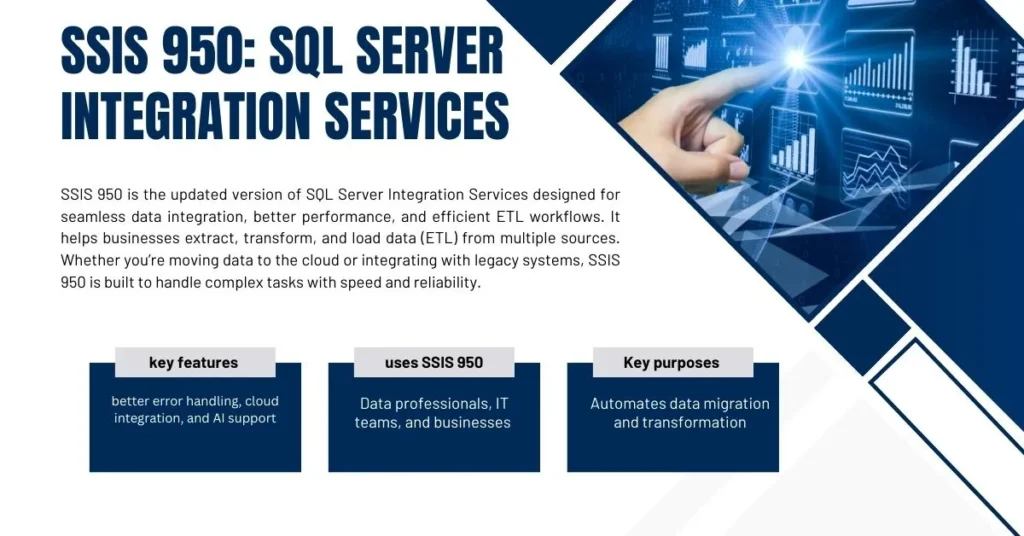SSIS 950 is the updated version of SQL Server Integration Services designed for seamless data integration, better performance, and efficient ETL workflows. It helps businesses extract, transform, and load data (ETL) from multiple sources. Whether you’re moving data to the cloud or integrating with legacy systems, SSIS 950 is built to handle complex tasks with speed and reliability.
What Is SSIS 950?
SSIS 950 stands for SQL Server Integration Services Version 950, a part of Microsoft SQL Server. It’s used to build and run workflows that manage data movement and transformation between systems.
Key purposes of SSIS 950:
- Automates data migration and transformation
- Connects multiple data sources including flat files, cloud platforms, and databases
- Improves data quality, consistency, and accessibility
- Supports large datasets and high-performance data flows
Why SSIS 950 Matters for Businesses
SSIS 950 offers advanced capabilities that streamline ETL processes and data integration. It’s especially useful for small businesses, large enterprises, and data professionals who need scalable, cloud-ready tools.
Key Benefits:
- Scalability: Handles small to massive datasets
- Automation: Reduces manual data entry and transformation
- Cloud Compatibility: Integrates with Microsoft Azure and other platforms
- Error Handling: Improved logging and diagnostics features
- Speed: Optimized performance for data flow and package execution
Core Features of SSIS 950
Enhanced ETL Tools
- Drag-and-drop design for building workflows
- Pre-built components for data extraction, transformation, and loading
- Advanced transformations like data cleansing, sorting, merging
Support for Various Data Sources
- SQL databases
- Flat files (CSV, TXT)
- Excel spreadsheets
- Web services
- Cloud platforms like Azure
Data Flow Optimization
SSIS 950 improves data flow pipelines with parallel execution, buffer tuning, and partitioning. This allows for:
- Faster processing of large datasets
- Improved memory management
- Reduced bottlenecks in data movement
Better Error Handling
- Custom error outputs for each task
- Detailed logging options
- Built-in retry and alert systems
Integration with Cloud and AI
SSIS 950 supports cloud-based workflows and AI integration using Microsoft tools.
- Azure Data Factory integration
- Machine learning model support
- Cloud storage compatibility
Common Use Cases for SSIS 950
- Data warehousing
- Business intelligence dashboards
- Legacy system modernization
- Cloud data migration
- Data quality improvement
- Automated report generation
How SSIS 950 Handles Data Integration
Extracting Data
Pulls from multiple sources, including:
- Databases
- APIs
- Flat files
- Cloud storage
Transforming Data
- Converts formats
- Cleans inconsistent entries
- Merges and splits fields
- Maps old data to new structures
Loading Data
- Loads into data warehouses or SQL Server
- Triggers events based on load completion
- Ensures high data integrity
Designing SSIS 950 Packages
Each SSIS package includes tasks, workflows, and connections.
Key Design Tools:
- Control Flow: Organizes tasks and containers
- Data Flow: Manages how data moves and changes
- Parameters and Variables: Makes packages reusable and dynamic
- Configurations: Helps manage environment-specific settings
Best Practices:
- Use logging and checkpoints for monitoring
- Separate control and data flows for clarity
- Use expressions for dynamic logic
Performance Metrics and Monitoring
SSIS 950 includes built-in tools to track:
- Package runtime
- Row counts
- Error rates
- Throughput and latency
You can also use SQL Server Management Studio (SSMS) or Performance Monitor for deeper analysis.
Security in SSIS 950
Security is crucial in data processes. SSIS 950 supports:
- Role-based access
- Package encryption
- Credential protection
- Secure data transfer protocols
Comparison: SSIS 950 vs Older Versions
| Feature | SSIS 2016/2017 | SSIS 950 |
| Cloud Integration | Limited | Full Azure Support |
| Performance Tuning | Manual | Auto-optimized |
| AI Integration | Not Supported | Supported |
| Error Diagnostics | Basic Logs | Detailed Tracking |
| UI Experience | Outdated | Improved |
Challenges Users May Face
Even with SSIS 950’s updates, some challenges include:
- Complex initial setup
- Need for training on new features
- Limited support for non-Microsoft platforms
Tips:
- Follow a step-by-step guide
- Use Microsoft Learn or community forums
- Test with small datasets first
Real-World Applications
Businesses in retail, finance, health, education, and web design industries use SSIS 950 for:
- Daily data synchronization
- ETL for analytics dashboards
- Sales performance tracking
- Customer behavior analysis
SSIS 950 and Web Design in Columbia
If you’re working in web design in Columbia, South Carolina, and need regular analytics or customer data integration, SSIS 950 simplifies your ETL processes. It connects to CRMs, form submissions, and eCommerce platforms with ease.
Conclusion
SSIS 950 brings powerful tools to streamline ETL, improve data integration, and support cloud-ready operations. From managing workflows to improving data quality, it’s designed to fit both small business needs and enterprise-level demands.
Whether you’re new to ETL or upgrading from an older SSIS version, this version delivers performance, scalability, and control.
FAQs About SSIS 950
What is SSIS 950 used for?
SSIS 950 is used for extracting, transforming, and loading data between systems. It helps automate workflows, manage large datasets, and improve integration.
Is SSIS 950 cloud-compatible?
Yes, SSIS 950 integrates smoothly with Microsoft Azure and other cloud platforms. You can deploy packages directly to the cloud.
What are the key features of SSIS 950?
SSIS 950 features include enhanced data flow tools, better error handling, cloud integration, and AI support. It also improves performance and scalability.
Who uses SSIS 950?
Data professionals, IT teams, and businesses of all sizes use SSIS 950. It’s especially useful for data migration, warehousing, and reporting.
How is SSIS 950 different from previous versions?
SSIS 950 offers better performance, deeper cloud integration, and smarter error diagnostics. It’s more efficient and user-friendly than older versions.

